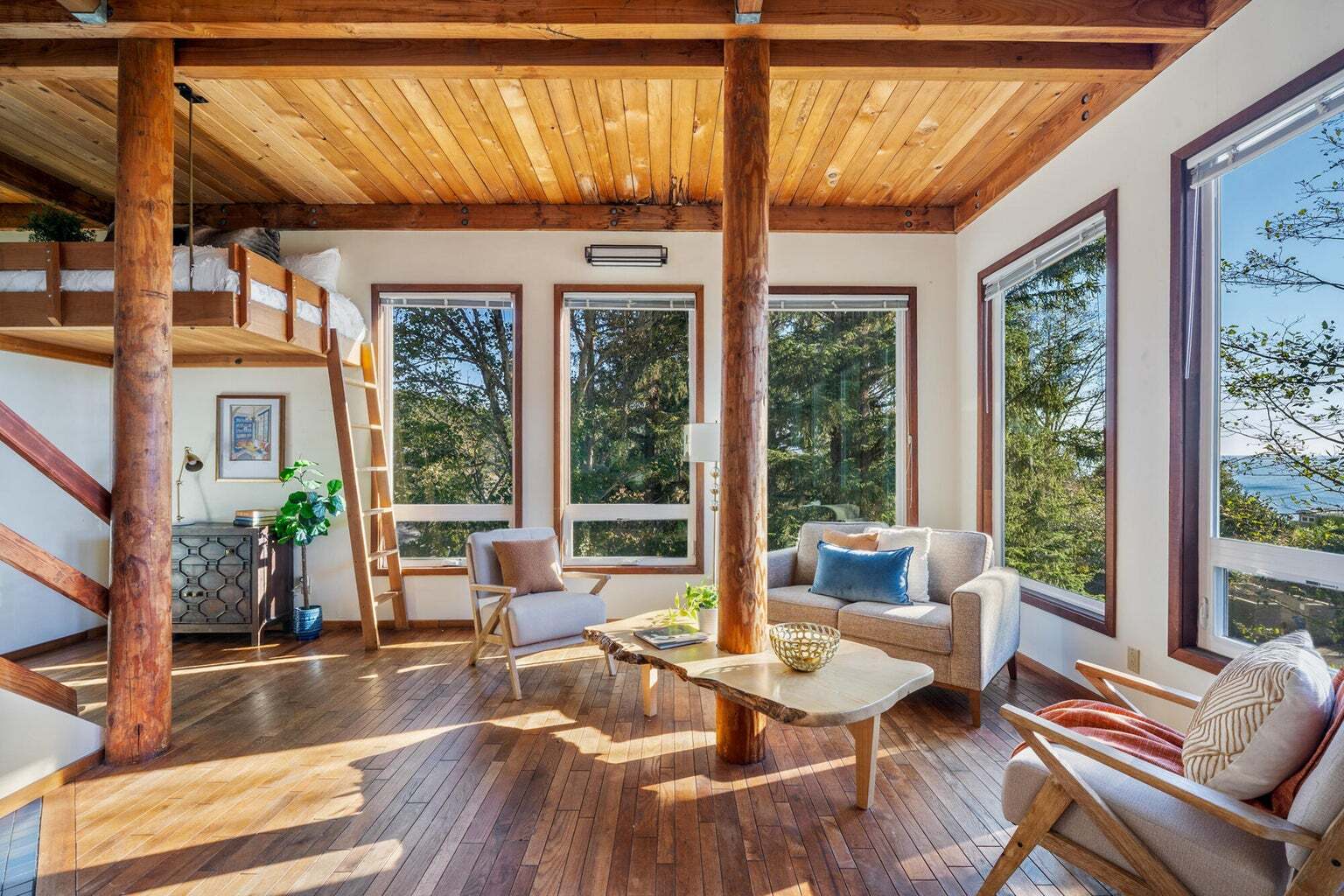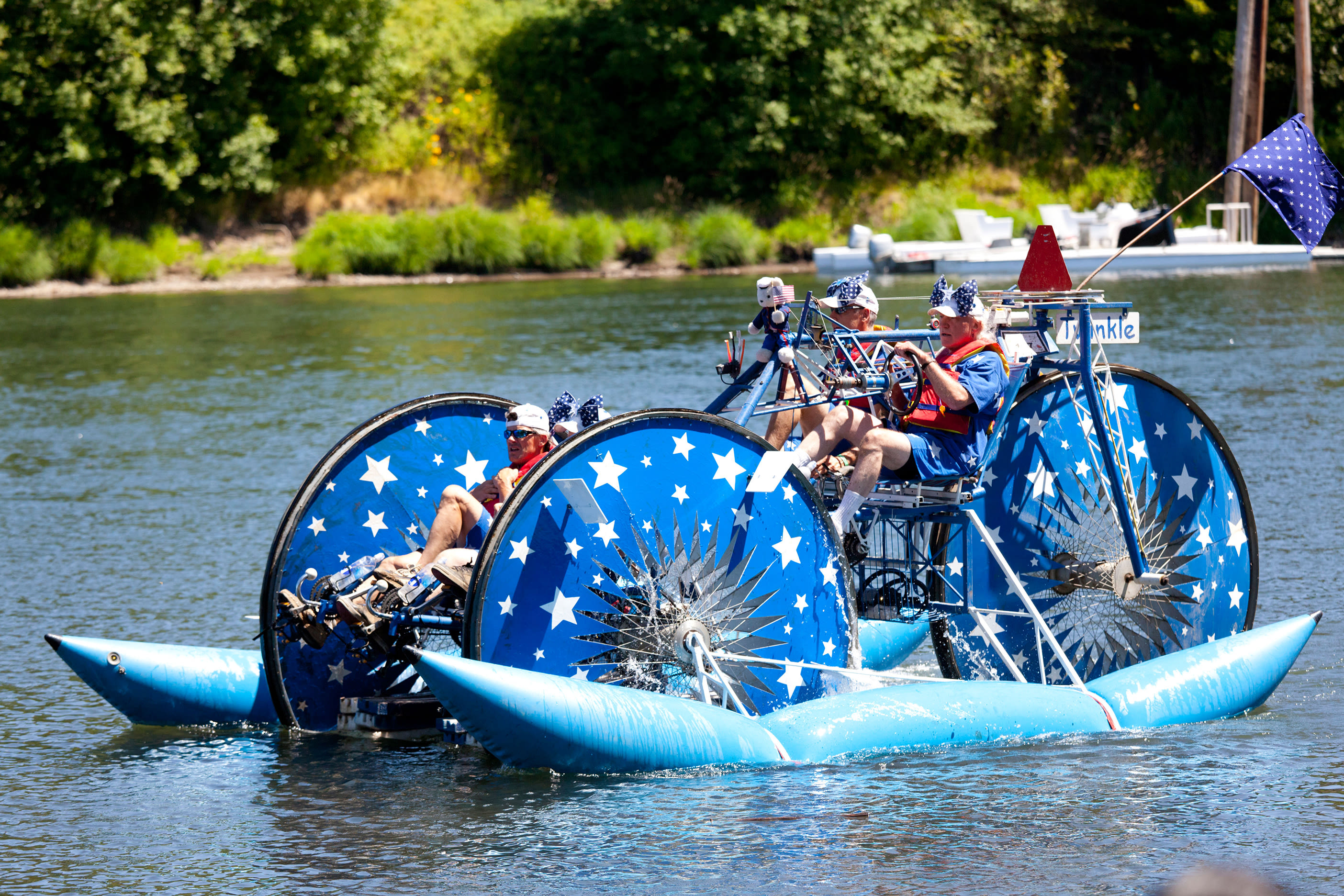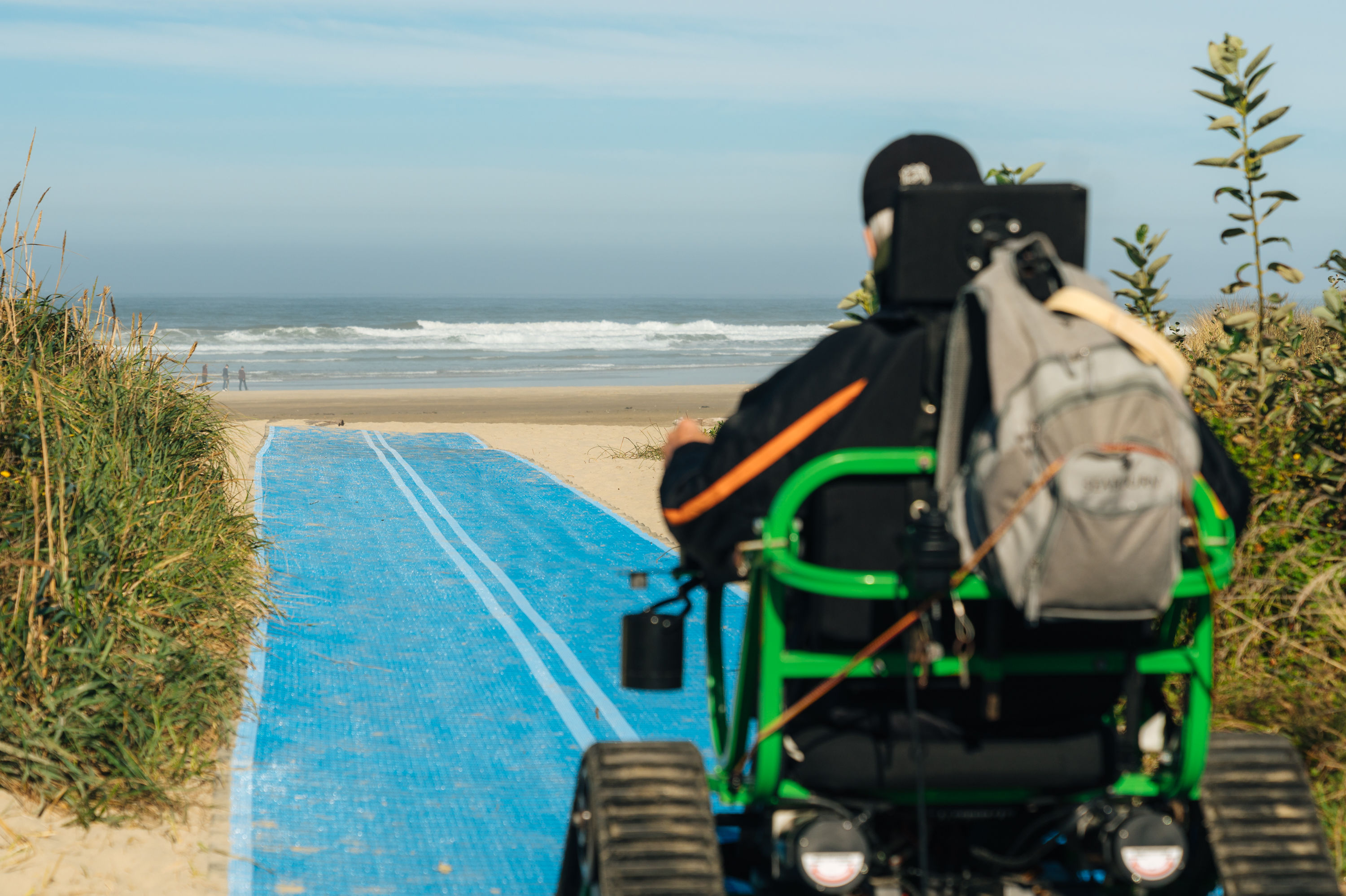The Hidden Coast
It may sound boastful, but it’s also a simple truth: There is no coastline in America more worthy of exploration than our little stretch of the Pacific. For unlike those flat, white beaches of Florida, or the overpopulated SoCal shores, the Oregon Coast does not brazenly expose itself for all the world to see. On the contrary, courtesy of vertigo-inducing cliffs, colossal dunes, peninsulas that divide the shore into a hundred paradisiacal coves, and rivers that course down the Coast Range before opening their mouths to the sea, the Oregon Coast prefers to keep its secrets. Which it usually does—at least from most of the tourists who ply Highway 101 each year.
For such idle travelers, there are vistas enough: overlooks, haystack rocks, lighthouses, what have you. But it stands to reason, given the terrain, that some of the coast’s most sublime spots are hidden: You have to work to find that perfect view of the lighthouse from the end of a tree-lined trail, or that clapboard bistro with the windows looking out on the docks, where fishermen unload the catch of the day. Equal parts pride and selfishness make us want to keep such knowledge from the rest of the country. But we think it only right to share these top-secret locales with the people who live in close proximity to them: you.
Within the following pages, you’ll find a guide to 34 out-of-the-way places, from the tip of Washington’s Long Beach Peninsula to a secret beach (called, no kidding, Secret Beach) fewer than 20 miles from the California border. To make your explorations easy, we’ve laid them out mile-by-mile, north to south. This is the guide to those elusive places that you always had a feeling were right around the next bend in Highway 101, but that you’ve never been able to find. Now, at long last, you can.
1. Leadbetter Point State Park
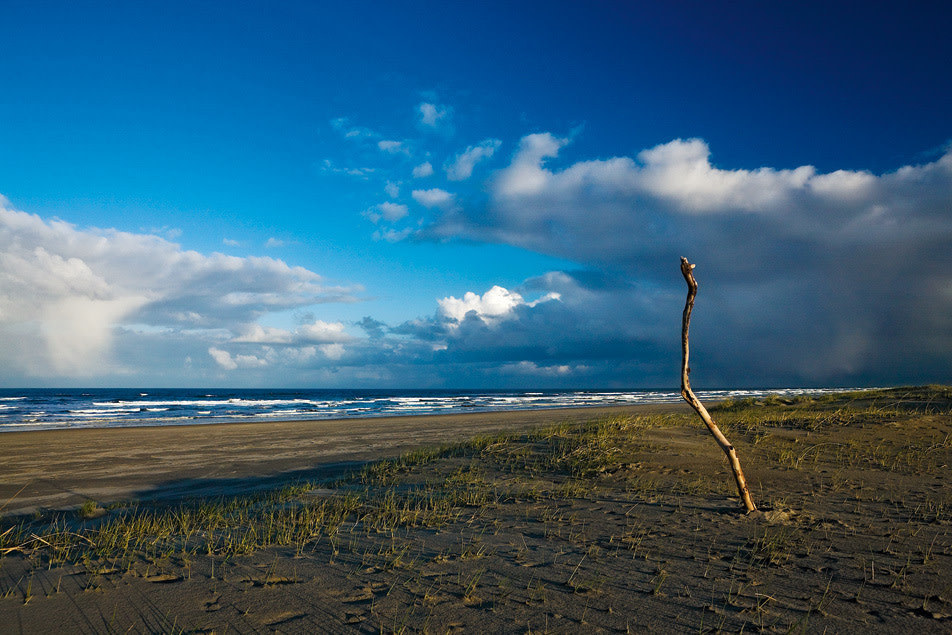
Leadbetter Point State Park on the Long Island Beach Peninsula.
Image: Daniel Root
The Long Beach Peninsula—that finger of land separating the Pacific Ocean from Washington’s Willapa Bay—eventually narrows at its northernmost tip to a fleeting strip of sand that shape-shifts according to the vagaries of wind and wave and tide. Standing way out here, salty air whipping about your face, you’ll witness a seamless mingling of land and sea, a place in such constant flux that it seems as if the earth itself is being endlessly reborn. Few, however, ever exert the effort required to see it. Cars are banned from Leadbetter Point State Park and Willapa National Wildlife Refuge—the two parks that protect this area’s wind-rippled dunes and forests of alder, spruce, and pine. Which means that in order to reach the peninsula’s ever-changing end, you’ll first have to hike Leadbetter’s easy 1.3-mile Blue Trail to the Pacific and then continue north along the shore for 3.5 miles (past prime habitat for the endangered snowy plover). Only then will you be delivered to the loneliest place in Washington, where you’ll experience the restorative Zen of total isolation. From Oysterville Road, drive three miles north of Oysterville on Stackpole Road and park in the Leadbetter Point parking area; 360-902-8844; www.parks.wa.gov
2. Jimella’s Seafood Market & Community Store
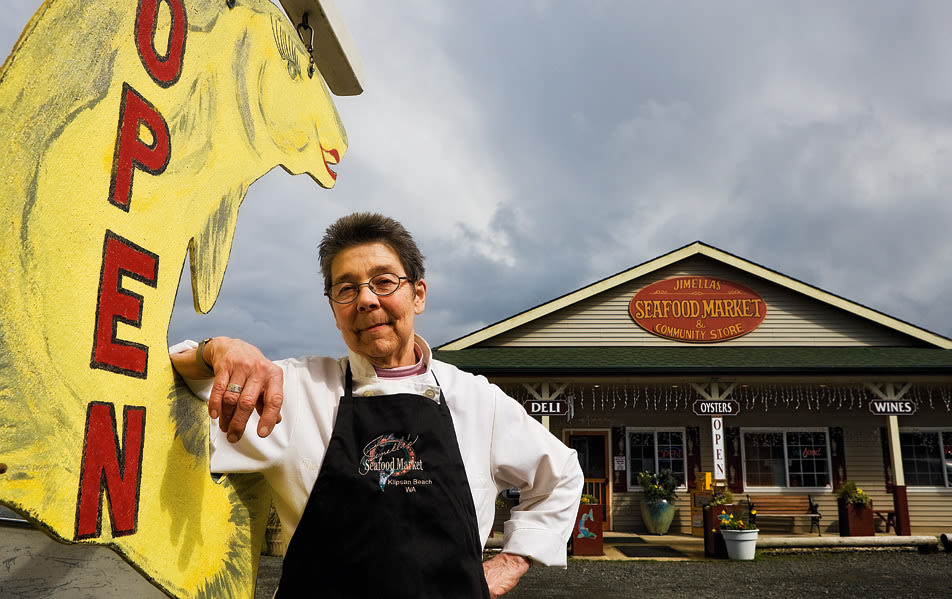
Jimella Lucas owns Jimella’s Seafood Market and Community Store in Klipsan Beach, Washington.
Image: Daniel Root
Even when the ocean is within earshot, a good fishmonger is a pleasure to find—which is why, on your way back from Leadbetter, you should stop at Jimella’s Seafood Market & Community Store in the village of Klipsan Beach. True, the seafood case is scarcely bigger than the fridge in your kitchen. But what it contains is the best local fin and shellfish on the peninsula—and, we’d be willing to wager, in all of southern Washington. The reason for such perfect bounty? Owner Jimella Lucas is the former chef and owner of the Ark seafood restaurant in nearby Nahcotta; as such, she’s been buying fresh catch in the area for over 25 years. Most likely, she knows the person who caught your dinner by first name, as well as where he’s been fishing and whether or not he runs a tight ship. Closed Mon; 21712 Pacific Way, Klipsan Beach, Wash.; 360-665-4847
3. Audubon Cottage
With a broad bank of windows facing both south and east across the Columbia River, this cozy double-decker cottage hides one of the only beds on the coast where you can wake to the rosy sun rising just above your toes. The architects of the Audubon Cottage—opened two years ago by the owners of the adjacent China Beach Retreat—obviously spent a lot of time figuring out how to get you closer to nature both inside the cottage (one bathroom door was hewn from a 1,000-year-old redwood log that washed up onshore) and outside of it (an outdoor soaking tub places you at eye level with the tips of swaying sea grass). It’s the perfect getaway for couples seeking a soul-healing retreat of absolute stillness, interrupted only by the splash of bird wings lighting upon the water. From $295; 222 Robert Gray Dr, Ilwaco, Wash.; 360-642-5660
4. Port Bistro
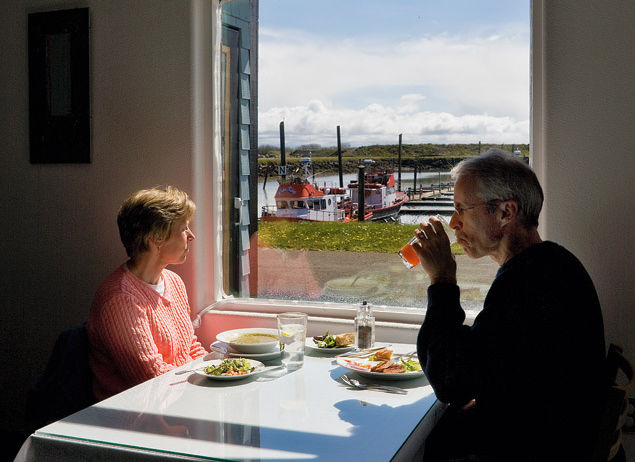
Image: Daniel Root
The Ilwaco Marina may be redolent of wet rope, fish bait, and boat fuel, but inside this dockside bistro, the air undergoes an olfactory transformation. That’s because the Chicago-born chef, Larry Piaskowy, grills thick steaks like the stockyards are out front rather than the ocean. But the seafood dishes like a tender, saffron-perfumed poached sole let you know you’re in the hands of a cook with a sensitive palate. Grab a table by the window and watch the boats unload their quarry. Or sit at the copper bar and ask Larry where the oysters are from (he’ll point to the bay). Closed Wed; 235 Howerton Way, Ilwaco, Wash.; 360-642-8447
5. The Ship Report
Wondering what in the blimey those hulking container ships are carrying up the Columbia River? Next time you’re in Astoria, satiate your curiosity by tuning into the morning Ship Report on the town’s community radio station, KMUN. For five minutes—starting promptly at 12 minutes to 9—host Joanne Rideout identifies each ship scheduled to pass, what it’s carrying, and where it’s bound. For the next five minutes, she delivers maritime news, a marine forecast, and a description of ocean crossing conditions—a rich backdrop against which to imagine life aboard those big ships slowly steaming by. Listen to the Ship Report from 8:48-8:58 a.m. on KMUN 91.9 FM.
6. Drina Daisy

Image: Daniel Root
When Astoria’s fog clamps down, you’ll find no better consolation than Drina Daisy’s Bosnian-style comfort food. Owner Fordinka Kanlic makes meals much like she did in her restaurant outside Sarajevo for more than 30 years, roasting whole, tender young lambs on a spit; baking fresh bread; and stewing richly spiced beef goulash. With a half-liter of Karlova?ko Croatian pilsner and a seat near the kitchen, any meal here can turn a gray day in Astoria into the best damn foggy afternoon you’ve ever had. Closed Mon, Tue; 915 Commercial St, Astoria; 503-338-2912
7. The other Flavel house
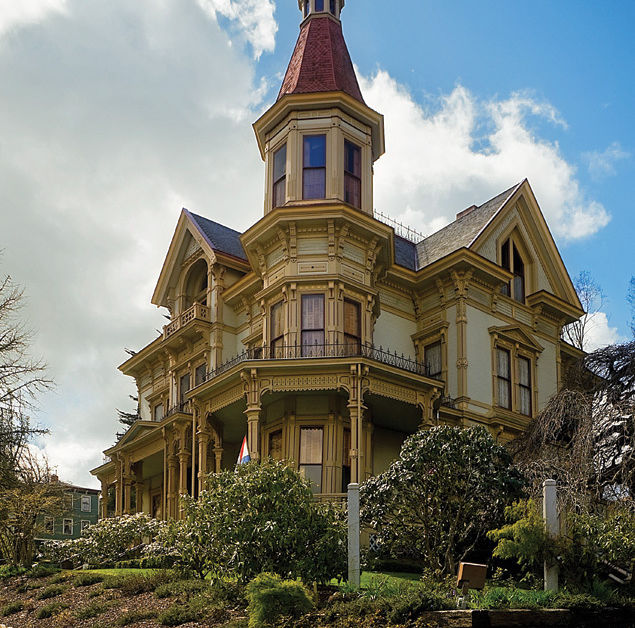
Image: Daniel Root
You’ve likely seen the Flavel House Museum, the grand Victorian in downtown Astoria built by Captain George Flavel in the 1880s. But there’s another Flavel house just eight blocks away—a weather-beaten mansion that sits idly in disrepair. The house has been vacant ever since its former occupant, George’s great-grandson Harry, went on the lam in 1983 after his conviction in connection with a stabbing. The cops eventually caught Harry—he was busted for stealing towels from a hotel. But the ghostly manse still stands, kept by the Flavels, according to local gossip, in a state of purposeful neglect as a revenge of sorts, intended to remind all who know the house’s story of the Flavels’—and Astoria’s—former glory. To gawk at the house, drive to the corner of 15th Street and Franklin Avenue.
8. Bayocean Spit
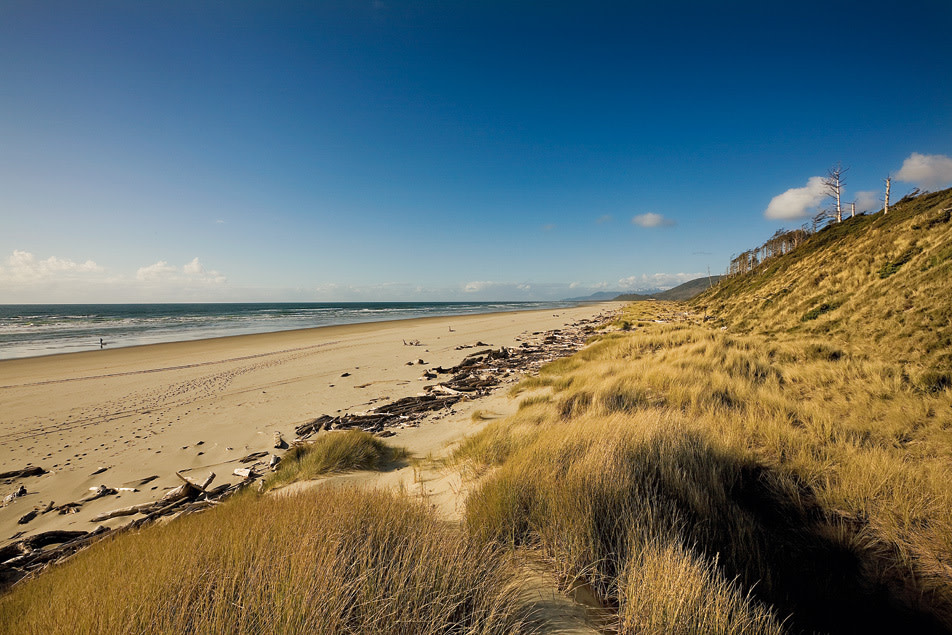
Bayocean Spit forms the western side of Tillamook Bay.
Image: Daniel Root
So mesmerizing is this four-mile-long spit that way back in 1906, one Thomas Potter, a real estate speculator from Kansas City, dreamed of turning it into the “Atlantic City of the West.” Poor Potter. After he’d constructed a grand hotel and a fabulous natatorium, the Army Corps of Engineers built a jetty on the north side of the Tillamook Bay inlet. Erosion patterns slowly shifted, and over the course of 20 years, Potter’s idyllic resort by the sea fell right into it. But Potter’s loss is your gain, for today this beachfront rim that forms the western side of Tillamook Bay is a spare and quiet wilderness crisscrossed by lonely trails that loop through thickets of salal and pine, and amble over grassy dunes. Keep in mind, though, that this wilderness is bigger than it looks—a round trip to the seldom—visited south jetty requires a commitment of 8.1 miles. But on your return, as you look out at the lights of Garibaldi and Bay City twinkling across the water, and as a sunset fires up the horizon, you’ll be glad for Potter’s fate and even gladder you made the trek. From Tillamook, follow the signs to Cape Meares. Turn right on Bayocean Road, and right again just across from milepost 5. Drive about a mile to the parking area on the dike.
9. Hug Point State Recreation Site
At high tide, Hug Point is but a blip of beach, really. What elevates this place south of Cannon Beach from ho-hum to extraordinary is revealed at low tide, when you can easily walk around the rocky head on the north end of the beach to a pristine sandy cove. Surrounded by twisted, ruddy basalt cliffs bent around two dark caves, and graced by a waterfall centerpiece, this little indentation by the sea is so picture-perfect, you might feel as though you’ve stumbled onto the set of Planet of the Apes. Continue walking north to reach the old stagecoach road (left) where wagons once rounded the precarious point. Remember to watch your tide tables, or you, like Charlton Heston, may find yourself detained in terra incognita. ?800-551-6949; oregonstateparks.org
10. Roseanna’s Café
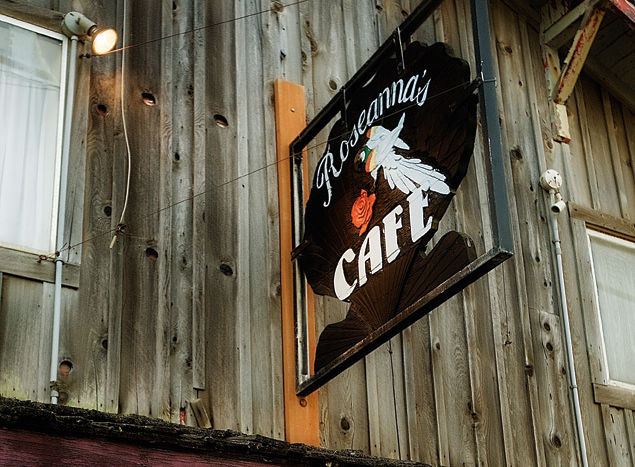
Image: Daniel Root
Tucked into an unpainted building with only a weatherworn sign out front to announce it exists, Roseanna’s appears an unremarkable place. And the inside? It looks a bit like a grandma’s living room, what with the pastel tablecloths, the faux ivy, and the mini-carnations that often grace the tables. But take a seat near the back window and you’ll realize that plain-looking Roseanna’s is actually a raving beauty, perched as it is above the wide, sandy beach, with views of the mammoth Three Arch Rocks. And the food? Simple and delicious. The chef will prepare the day’s catch one of six different ways (dusted with Cajun spices and served with chutney butter, for instance). 1490 Pacific Ave; 503-842-7351
11. Munson Creek Falls
The highest waterfall in the Coast Range lies just a mile and a half off Highway 101, at the end of a hike so short, you can check this worthwhile Oregon landmark off your life list in about 15 minutes (or less, if you’re quick). The 319-foot-tall falls slice through a towering Sitka spruce forest, alongside what might be the most heavily moss-laden trees in our considerably moss-laden state. Make the trip on a late August day, when the shady quarter-mile stroll is a soothing salve to summer heat. Turn east on Munson Creek Road—road signs help guide the way. Proceed two miles to the trailhead.
12. The Cottages at Cape Kiwanda
True, these condos aren’t exactly hidden. In fact, they stand front and center on the beach by the foot of Cape Kiwanda. What you likely don’t know, however, is that within this brand-new 18-unit development (most of the units have been sold as time-shares) are six amazingly well-appointed two- and three-bedroom suites reserved for nightly rentals. While everyone else is strolling the beach, gawking at the cape and the dory boats, you can do the same from your private balcony. Loaded with absolutely everything (like fireplaces, a Jacuzzi, an Xbox, and a shower tiled with river stones), these suites make you feel like you’re staying in the house of a millionaire, one who just hasn’t had time to make it home yet. Rates might be steeper than the giant sand dune outside your window—but when an occasion calls for a splurge, this place is worth it. $399-549; 33105 Cape Kiwanda Dr, Pacific City; 888-965-7001
13. Hart’s Cove
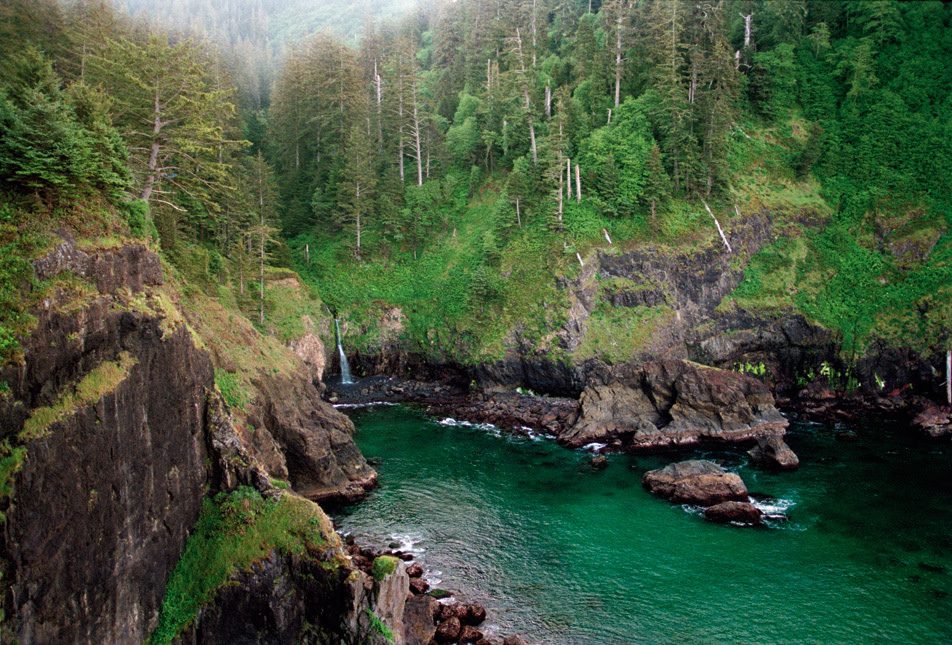
Hart’s Cove, a hike through old-growth forest on the coast.
Image: Mark Gamba
For most of the year, the road to the trailhead of the coast’s most spectacular hike is blocked by a locked gate, a barrier that lets the endangered Oregon silver spot butterfly and hairy checkermallow flower peacefully do whatever it is they do in a lonesome seaside meadow. But on July 16, the gate is drawn back, allowing you to drive to the 2.7-mile trail’s start. After winding through an old-growth forest that clutches to the windy cliff tops, the trail dissolves into an open bluff some 900 feet above the sea. Keep to the left to hike down to Hart’s Cove itself, where the barks of sea lions reverberate off sheer walls and a waterfall arcs into the brilliant blue bay. At the crest of the hill south of Neskowin, turn west at milepost 101.5. Keep left at the fork in the road to reach the trailhead parking area.
14. Otis Café
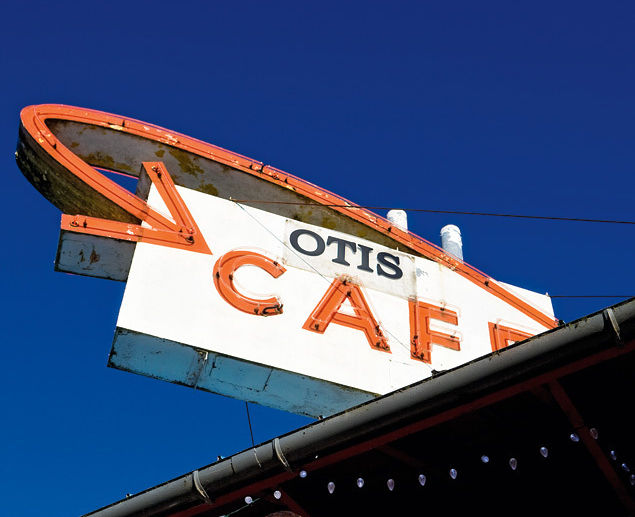
Image: Daniel Root
Since the 1920s, this diminutive diner just a mile east of Highway 101 on Highway 18 has understood that roadside fare need not be of the greasy spoon variety. Today the café—with four booths, one table, and a handful of seats at the counter—is still worth a detour: Current owner Jeff England, who bought the place in 1996, has kept it exactly as he found it, and he’ll still sling you a hearty breakfast plate piled high with the café’s trademark German hash browns, or serve you a house-made slice of marionberry pie. Don’t forget to pick up a loaf of freshly baked molasses bread for the road. It’s a pantry staple for Otis locals, and a perfect snack for a hike to Hart’s Cove. 1259 Hwy 18, Otis; 541-994-2813
15. Nelscott Reef
You may have heard of this legendary Oregon big-wave surf spot off the coast, but odds are that you’re not sure exactly where it is. That’s understandable. The monster swells only appear come winter, and they break more than a half mile offshore. But when the Nelscott Reef TowIn Classic gets underway—usually sometime in December—you can haul a beefy set of binoculars down to the Lincoln City beach (just behind the goofy little Christmas shop north of Spanish Head) to watch the world’s best charge down 30-foot waves. One thing not to ask, even in jest: “Hey, is that a great white shark?” The dates of the Nelscott Reef TowIn Classic depend on ocean conditions, so if you want to go, you’ll have to check www.nelscottreef.org almost daily, beginning in October.
16. Boiler Bay
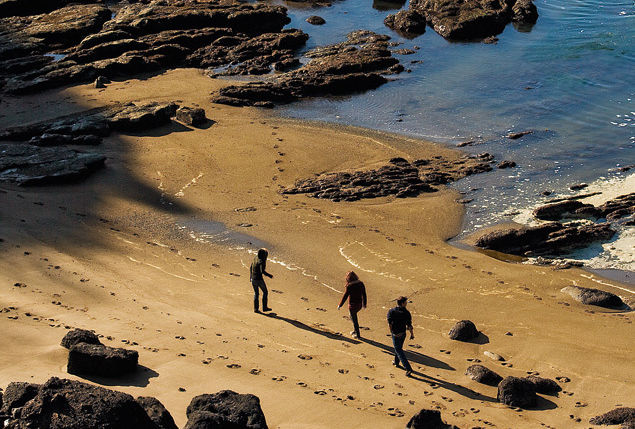
Boiler Bay’s tide pools are among the most biologically diverse on the Oregon coast.
Image: Daniel Root
Most folks content themselves with gazing at Boiler Bay from the high promontory at Government Point, which makes as fine a place as any to zone out on that most classic of scenes—raging waves smashing against a cliff face. What many don’t know is that you can actually walk down to Boiler Bay itself, which holds some of the most biologically diverse tide pools on the entire coast. To find the steep, narrow trail leading to the water’s edge, park on the west side of the highway just before you reach Boiler Bay State Park (at the tiny pullout). Scramble down the steep, rocky slope to enter another world made of twisting channels and mossy green cliffs, one that’s populated by the brilliantly colored denizens of the intertidal zone. This is one of the only spots on the coast where you’ll find the unusual, prehistoric-looking gumboot chiton (a type of mollusk), several types of uncommon corals, and an especially rich assemblage of sea slugs and sessile invertebrates—creatures like bright sea sponges that hold fast to the rocks and make this cold-water bay their permanent, kaleidoscopic home. Look to the bay’s center at low tide and you may even spot its namesake: a rusty boiler left here in 1910 after a fire consumed the steamer J. Marhoffer. 800-551-6949; oregonstateparks.org
17. Rocky Creek State Scenic Viewpoint
It seems a rather ordinary park, this grassy oceanfront field two miles south of Depoe Bay—but Rocky Creek happens to be home to the Pacific Ocean’s very best front-row seat, a solitary bench propped on the point’s edge, where, tranquilized by crisp sea air, you can while away an hour contemplating the waves erupting just below your feet. After a spell of meditation, walk north past the park bathrooms into the stand of pine and spruce to discover a short, winding trail with peekaboo viewpoints of the spectacular Whale Cove, purported to be the site of New Albion, Sir Francis Drake’s 1579 campsite during his circumnavigation of the globe. 800-551-6949; oregonstateparks.org
18. Otter Crest Loop Road to Cape Foulweather
Don’t simply obey the highway signs that steer you to a rather mundane approach to the 500-foot-high promontory of Cape Foulweather. Instead turn west on Otter Crest Loop, just south of Rocky Creek State Scenic Viewpoint. The short drive slowly winds up the cliff side, offering panoramas (like this one) as you climb the north slope of the historic cape—the first location on the coast named by Captain Cook during his exploration of the Pacific Northwest in 1778.
19. Yaquina Head Outstanding Natural Area
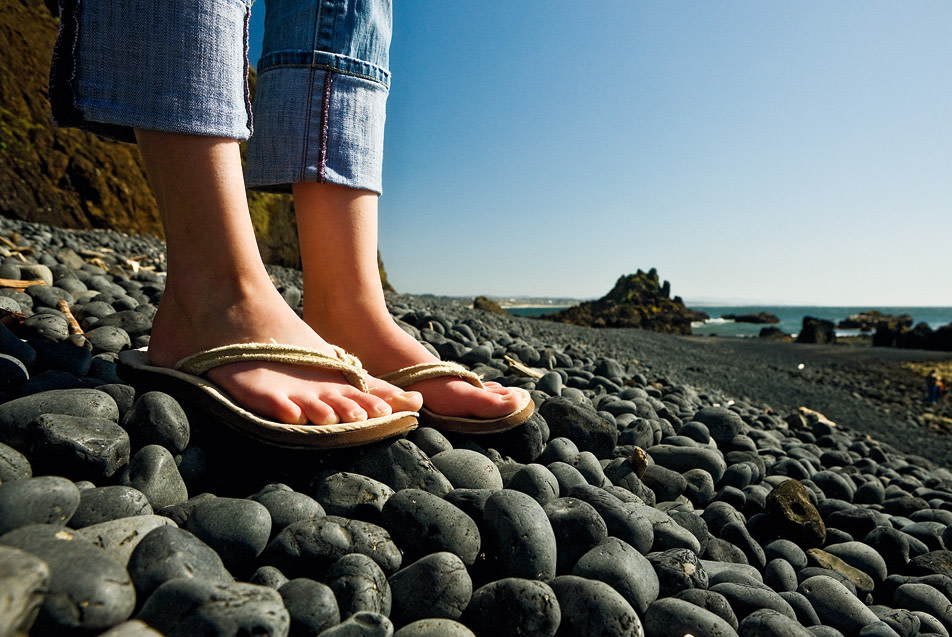
This promontory is a standard stop for tourists, who trundle out of their vehicles by the thousands to shoot photos of the coast’s tallest lighthouse. But most overlook Yaquina Head’s best feature—the beach of slick black cobblestones that rings the misty inlet. To reach this Martian shore of ancient basalt, walk down the paved trail on the south side of the lighthouse. Where the pavement ends, step onto the clacking, rolling stones. Have a seat. Then close your eyes and listen to the ocean as you’ve never heard it, hissing and ticking as the surge washes in and then retreats across the rocks. When you open your eyes, don’t be surprised to see a harbor seal, bobbing in the surf and staring back at you, wondering why on earth you’re wearing that silly grin. $5 day-use fee; 541-574-3100; www.blm.gov/or/resources/recreation/yaquina
20. Waldport Seafood Company
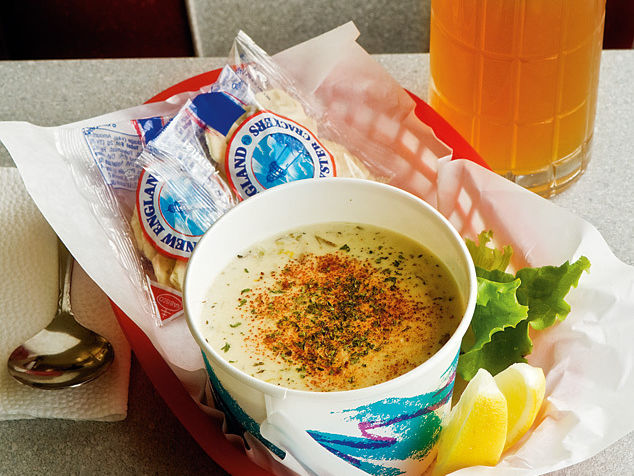
When you see steam ushering from this humble red-painted shack overlooking Alsea Bay, it means the crab-cooker is aboil—your cue to pull over and sidle up to the counter for a fresh Dungeness crab cocktail; superb beer-battered fish and chips; or the exceptional, rich clam chowder, made fresh every day using the same chowder recipe they’ve used for as long as anyone here can remember. You’ll find no shortage of fancier chowders along the coast, as well as more aggressively marketed “world famous” ones, but none so perfectly enjoyable as this: rich and creamy with just the right balance of bacon, celery, and fresh ocean air drifting in off the bay. 310 SW Arrow St, Waldport; 541-563-4107
21. Preacher’s Cave
Named for Franz Edmund Creffield, the notorious early 20th-century minister (who had a penchant for public nudity), this cave is one of the oddest unmarked historical sites in the state. In 1906, Creffield convinced some 25 followers to seek “a new Eden” with him; then he instructed them to wait in a dank cave while he ran an errand (i.e., fleeing armed pursuers, one of whom gunned him down in Seattle). The cave is a far cry from Eden now, tagged as it is with graffiti, but you can still find it at low tide, if you’re willing to brave the rather precipitous terrain. Park at the pullout south of Neptune Park. Turn left after you step into the trees and walk down the steep sand slope. The cave is around the corner to the left.
22. Strawberry Hill
Cape Perpetua, just south of Yachats, is well known for its tide pools, geyserlike spouts, and heaving, surf-pounded chasms. But a sunny weekend in June can find this forested headland nearly as crowded as Black Friday at Jantzen Beach. Give yourself some breathing room by heading just two miles south to Strawberry Hill State Park. Tide pools, playful harbor seals and sea lions, the thunder of crashing waves—they’re all here, surrounding the black basalt island that you can walk to at low tide. The long, sandy beach stretching to the north is perfect for letting your car-bound kids run free (an expanse of space that’s hard to find up the road at Cape Perpetua), while to the south you’ll find a vastly different shoreline of dark cobbles, popular with agate hunters who search for the bright, translucent stones among the rocks that calve off the cliff. Park at the Strawberry Hill parking area near milepost 169.
23. Hobbit Trail and Hobbit Beach

Hobbit Trail at Hobbit Beach, near the Heceta Head lighthouse.
The quintessential postcard shot of the lighthouse at Heceta Head is taken from the wayside at Devils Elbow State Park, a shot so common, in fact, that it underscores the intrepid explorer’s need to seek out a fresh perspective. This you’ll find via a pullout just up the highway at milepost 177 (look for the China Creek Trailhead marker), where a network of footpaths known as the Hobbit Trails lead through the Sitka spruce and rhododendron (in bloom this month) to a close-up view of the lighthouse. After you’ve had your fill of the luminescence glinting off Heceta’s massive Fresnel lens, make your way back up the hill and turn left at the fork. Here, a half-mile descent through a dark, Middle-earth-like maze leads to Hobbit Beach, an enchanting stretch where the sun’s rays are often filtered through a fine gauzy mist. Park at the pullout at milepost 177.
24. Waterfront Depot
Tucked away at the far corner of Florence, the Waterfront Depot is one of the oldest-looking restaurants on the coast. Housed in the 1913 Mapleton train depot (which was sawed into three parts and floated 15 miles down the Siuslaw River to reach its present location), the kitchen now occupies the original ticket office. But the food is the real draw. Dutch-Indonesian owner Marianne Brisbane brings subtle but inspired international flavors to her daily-changing seafood menu—like her herbed Portuguese fish-and-shellfish stew, or her famous halibut, seared under a golden crust of sweet Dungeness crabmeat and offered for the remarkable price of $10. This is the kind of place you’ve been looking for on the coast for years. Unfortunately for you, the locals found it first, and unless you’ve called ahead, they’ll be ahead of you in line. Open daily for dinner; 1252 Bay St, Florence; 541-902-9100
25. Siuslaw Pioneer Museum
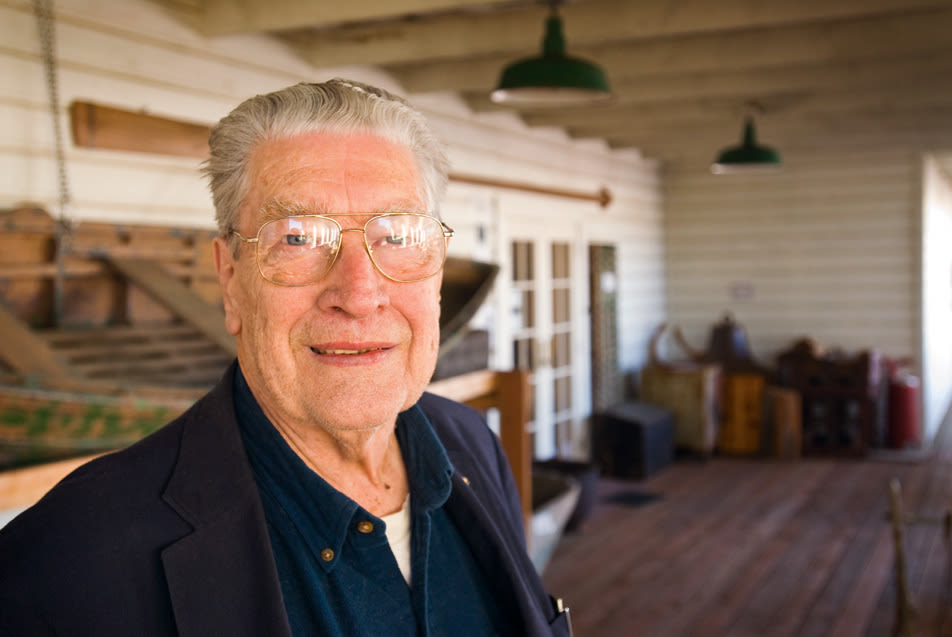
Relocated in 2006 from its batty old digs along the highway, the Siuslaw Pioneer Museum, now occupying the 100-year-old schoolhouse in the center of town, makes for a fascinating trip back in time, to the days before the highway connected the rural, central coast to the outside world. Crammed with Native American artifacts and bizarre Victorian-era relics (check out the musical toilet-paper holder), this museum, curated by Lewis Campbell (left), is also a treasure trove of oddities that have washed up on area beaches over the years, like a slab of yellow beeswax likely spilled from a Spanish galleon and a mammoth’s tooth that some speculate to be 12,000 years old. Which pretty much beats out the whole sand dollar you found earlier in the day. Open noon to 4 p.m., closed Mon; $3; 278 Maple St, Florence; 541-997-7884
26. Oregon Dunes
Tromp your way up the steep, sandy dune near this unmarked pullout to one of the area’s best viewpoints. Here, the barren, undulating sandscape sprawls out for miles—looking for all the world like some forgotten corner of the Libyan desert. And though an ATV or two might muck up that lonely panorama, take solace: You’ve dodged the crowds up the road at Honeyman State Park. Park at the milepost 196 pullout.
27. Umpqua Aquaculture
When you see the mountains of shells piled up outside this oyster-growing business’s nondescript gray building (just beyond the marina at Winchester Bay), this is is what you must do: Stop, fill up your cooler, and make for the picnic table at the northwest corner of the parking lot by the Umpqua River’s south jetty. Here, with just an oyster knife and a few lemons, some crusty bread and a cold beer, you will enjoy a kingly picnic, slurping down Umpqua Triangle oysters—among the most sought-after delicacies on the coast. What makes these mollusks so plump and sweet and beautifully pearlescent is how Umpqua Aquaculture owners Cindy and Vern Simmons cultivate them: Grown from seed in a triangle-shaped breakwater that’s protected from the pounding surf by two jetties, the oysters spend their lives clinging to ropes in calm, 30-foot-deep waters. As such, they contain nary a trace of dirt or mud. And since the oysters also never spawn (the sub-50-degree ocean water renders them sterile), they’re available (as are the lemons and the beer) all year round. 723 Ork Rock Rd, Winchester Bay; 541-271-5684
28. Hall and Schuttpelz Lakes
The familiar brown signs along the highway, festooned with white icons of tents and boats and RVs, all point traffic east to Tugman State Park. But directly across Highway 101, just a half mile up Wildwood Drive, lies the unadvertised day-use area of Hall Lake. Clamber your way up the sandy hills that ring the water and you’ll be privy to views that stretch for more than two miles to the ocean. Once you’ve had your fill of that arid vista, head down to the forest trail that wends through the trees on the banks of the Schuttpelz Lake, where you can bask in an oasis of shade. 541-271-6000; www.fs.fed.us/r6/siuslaw
29. Cape Arago
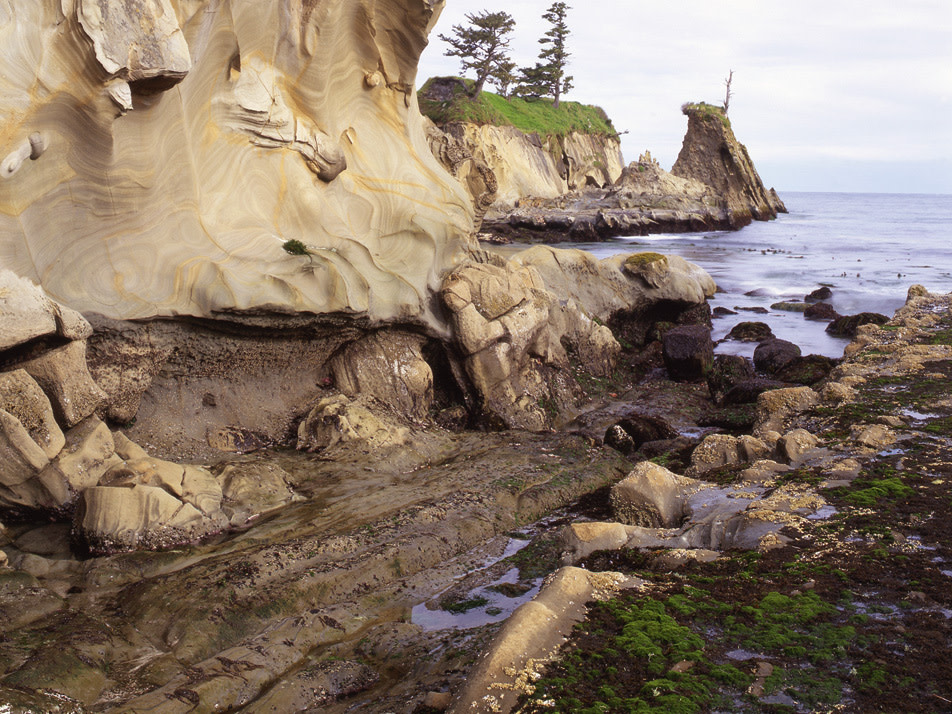
Image: Larry Geddis
Should you be clear down in North Bend and pass a highway sign humbly marked “Ocean Beaches,” you’d be wise to take a detour. Though 15 miles seems a long way to drive when beaches flank the rest of Highway 101, the sublime parks of the Cape Arago peninsula are among the best in the state. To access these seaside gems, pass through the marina in the village of Charleston, turn right off Route 240 onto Boat Basin Drive, and then turn left on Coos Head Loop. Keep right at the fork and you’ll be heading up the promontory of Coos Head. Pop out at points here and there to get the lay of the land: the broad sands of Bastendorff Beach; the defunct Cape Arago lighthouse on Chief Island; and, still stuck in the sand, the last 200-foot section of the New Carissa, which ran aground here in 1999.
Once you’ve had your fill of the views, continue south to the beach at Sunset Bay State Park, a great place to let the kids frolic in the surf, since the sheer rock walls diminish both wind and waves. But save a bit of your energy for Shore Acres, about a mile down the road, where you’ll find an observation building that was once the site of a cliff-top mansion. Although the home is gone, its lush gardens have been restored, and if you walk behind the lily pond and open the wooden gate, you’ll discover a hidden path leading to a concealed beach called Simpson Beach, which is neatly hemmed in by dramatic, sand-colored cliffs.
Back in the car, head another mile south to the overlooks at Simpson Reef, where, binoculars braced against the railing, you can watch northern elephant seals and sea lions. You may even catch a glimpse of one of Shell Island’s adorable harbor seal pups, born between March and June. Sunset Bay State Park, oregonstateparks.org; Shore Acres State Park, shoreacres.net
30. Langlois Market
In the tiny town of Langlois (pronounced, much to the fury of one local French émigré, “LANG-loy”), you’ll find what just might be the best general store in the state, fully provisioned with popcorn, flyswatters, cranberry wine, some good-looking steaks, and, most important, its self-proclaimed “famous” hot dogs. The short, plump beef franks from Hills Meat Co in Pendleton are diligently—though inexplicably—peeled from their snappy outer casings, then blistered brown under heat lamps. Best taken in the house-prescribed style, with the homemade sweet-hot mustard and sliced icebox pickles, they’re the single best meal on the coast that can be had for only $1.99. 48444 Hwy 101; 541-348-2476
31. Humbug Picnic Area
You’ll encounter plenty of opportunities to spend your dollars on myrtlewood products on your coast travels: Myrtlewood, which you’ll find in the countless salad bowls and sculpted knickknacks sold in tourist shops, is prized for its color variations, picked up from minerals in the soil. Few get to see the graceful, broadleaf evergreens, however, which typically grow farther inland—a good reason to seek out the thriving stand of trees at the picnic area located on the east side of 1,748-foot-tall Humbug Mountain. Pluck one of the leaves and smash it in your hand to release a fragrance of camphor and root beer, a scent that will linger long after your trip ends. Park at the Humbug day-use area lot.
32. Sisters Rock
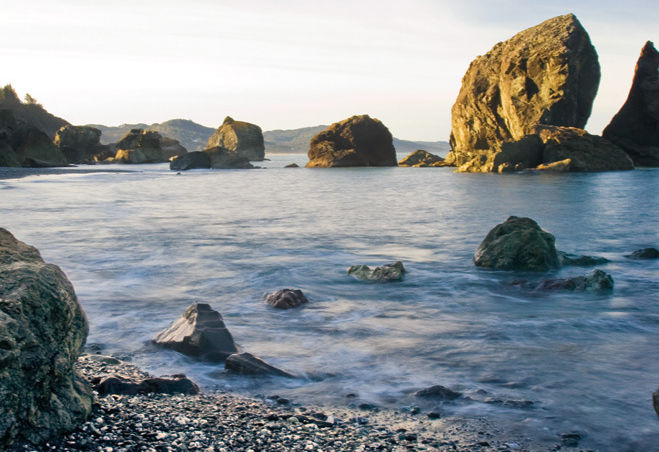
Ever since a locked gate was installed in front of the unmarked road leading to the beach at Sisters Rock (the parties at this unofficial campsite were getting a mite too rowdy), the 300-foot-high monolith has become substantially less popular. And that’s a good thing, for if you leave your car at the (still unmarked) pullout and walk a quarter-mile down the rutted road, you might find yourself alone atop the high, windswept isthmus, staring at a sheltered black-sand beach, a maze of offshore rocks, and a shelf of glittering tide pools. Climb up and over the rocks ahead to reach the mouth of Sisters Rock’s yawning sea cave. Here, as the foaming surf boils up and then peels away from the cavern’s darkness, as the wind billows and heaves, you can imagine yourself a castaway. And at this solitary spot, in a way, you are. Park at the unmarked pullout at milepost 135.
33. Up the Rogue
By the time you’ve made it all the way to Gold Beach, it’s easy to become weary of oceanfront splendor. Whale this, cormorant that—yep, 360-odd miles of beautiful coastline is a lot to swallow. The antidote lies up the Rogue River. Fresh water, eagles, big trees. This is what you need. Head out of Gold Beach on North Bank Road (don’t miss the right turn at the 3-mile mark), where, about 10 miles upriver, you’ll cross the spindly Lobster Creek Bridge. Make a right on the other side, and then a quick left onto the steep Forest Service Road 090 to reach the start of the Shrader Old-Growth Trail—an easy, mile-long loop hike through a stately grove of giant firs and Port Orford cedars. Cross back over the bridge and turn right up Silver Creek Road to find the half-mile trail to the largest known Oregon myrtlewood tree, which first took root 200 years ago. Finish with a cool dip in Lobster Creek’s clear waters, which pool up by the hairpin turn just north of the bridge (note that it dries up in late summer). Do all this, as prescribed, and you should be ready to embrace the sea once again. Head east out of Gold Beach on North Bank Road to begin the adventure.
34. Secret Beach
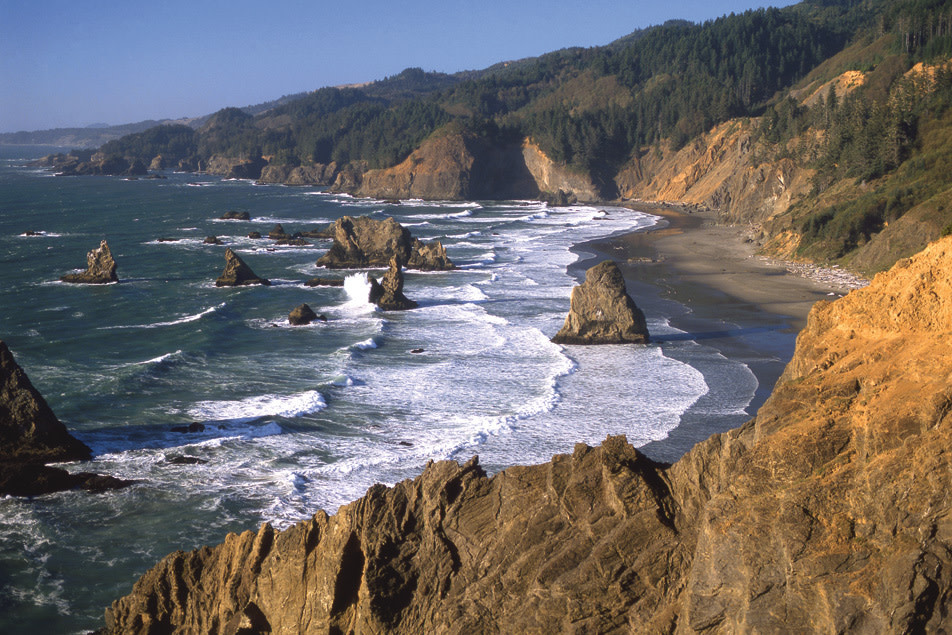
Secret Beach, a tiny piece of paradise at Milepost 346.
Image: Larry Geddis
At last, the end, and herein a fitting reward for traveling the full breadth of the Oregon Coast: the Samuel H. Boardman Scenic Corridor, nine miles of beach edged with twisting, giant spruce; great cliffs; and natural bridges of black stone. Meander down the sand far enough and you’ll undoubtedly score your own little patch of surf, but to find the tiny piece of paradise known as Secret Beach, you’ll have to expend some extra effort. At the northern end of the corridor, just over a half-mile south of the popular Arch Rock viewpoint, the shoulder widens into a gravel parking area, where the Oregon Coast Trail squeezes between the road and a popular overlook to Thunder Rock Cove—a steep-walled, aquamarine bay that’s rimmed with wildflowers in spring. But hike about a third of a mile north on the trail until you find the trickle of Miner Creek, and you’ll see a short path leading down to the pocket beach, a favorite of Curry County locals. This pristine strip of fine-grained sand sheltered from wind and heavy seas by cliffs of ocean-chiseled stone is the Oregon Coast at its best, where for a few fleeting moments it feels as if you yourself discovered the great, wild blue Pacific, and have left the din of civilization far behind. Park at the unmarked parking area between Mill Creek and Miner Creek.






